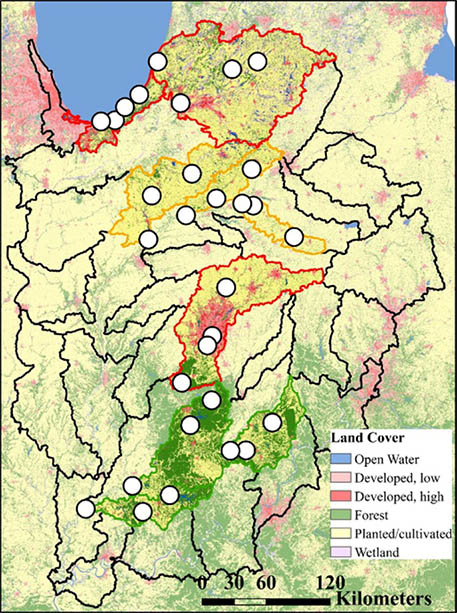Factsheet – A Contaminant of Emerging Concern in Indiana Rivers
A research project funded by the Indiana Water Resources Research Center through the U.S. Geological Survey’s 104B annual base grants (section 104 of the Water Resources Research Act of 1984, as amended).

Start Date: 2017-03-01
End Date: 2018-02-28
Total Federal Funds: $15,000
Total Non-Federal Funds: $42,921
Water quality degradation resulting from human activities represents a threat to environmental and human health. Contaminants of emerging concern, including microplastics (plastic particles <5 mm in size), are understudied in flowing waters of the Midwestern USA including in Indiana. Microplastics can enter rivers and streams through a variety of pathways (e.g., wastewater effluent, breakdown of larger plastic debris, atmospheric deposition) and can negatively impact aquatic organisms through both direct consumption with food and indirect contamination from sorbed toxins. This research quantifies the concentration and types of microplastics found in Indiana watersheds representing a gradient of land use (i.e., agricultural, urban, or forested).
Research Objectives
1. Provide Indiana managers, researchers, and decision-makers with a first-ever baseline measurement of the concentration and types of microplastics in major Indiana waterways. Information dissemination of this project’s results included presentations at statewide and national water symposia, peer-reviewed manuscript development, and the production of a short informational video available to the public.
2. Determine if microplastic concentration or type vary with land use and longitudinal position in the watershed. Three watersheds were selected representing each of three major land-use categories (forested, urban, agricultural). Within each watershed, at least three locations were sampled, generally (1) at the lower confluence of the watershed with a larger river to effectively sample the entire watershed, (2) near the midpoint of the watershed, and (3) in a headwater stream or tributary (control). Physical and chemical water quality parameters were collected along with bulk water samples for microplastic analysis. Microplastics were counted and categorized by type in the laboratory.

Indiana sampling sites (white circles), watersheds (black outlines), and associated land use. Watersheds outlined in green were targeted primarily as forested watersheds, orange as agricultural watersheds, and red as urban watersheds.
Researcher Profile

Major Conclusions & Significance

Figure 2. Microscopic images of assorted microplastic particles as characterized by Baldwin et al. 2016 (Env. Sci. Tech. 50:10377-10385) for Great Lakes tributaries. “Line” is more commonly referred to as “fiber”, the most common microplastic found in our samples.
What Does This Mean For Indiana?



